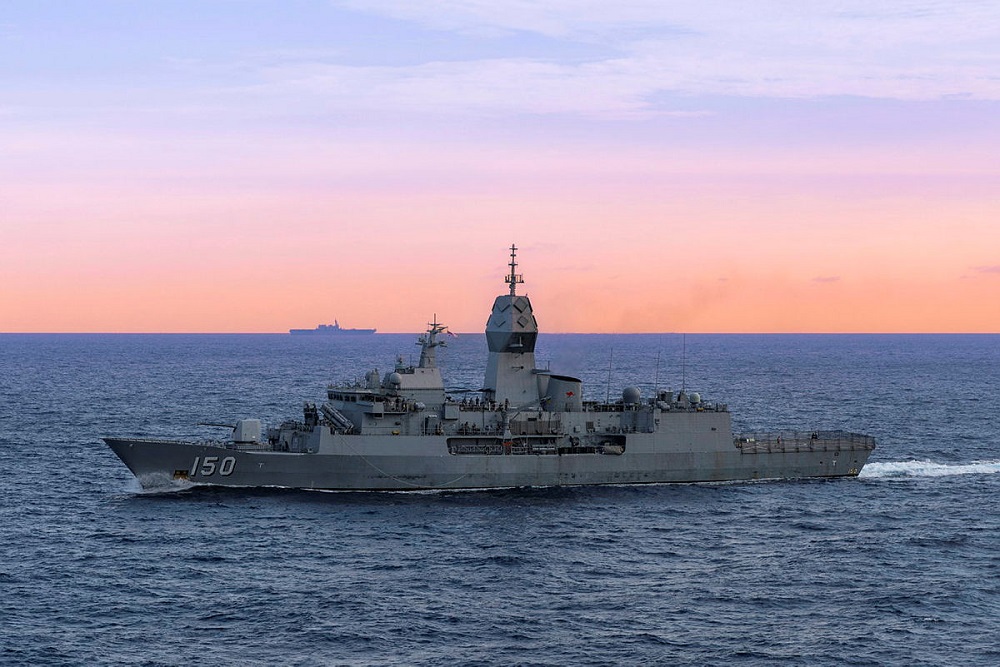
The Enhanced Lethality Surface Combatant review has laid out plans for the Royal Australian Navy to grow larger, with more firepower in the coming decade to ensure that it can meet the challenges highlighted in the 2023 defence strategic review (DSR).
Navy’s surface combatant force will see the three existing Hobart class destroyers proceed with a previously planned upgrade to their Aegis combat system from Baseline 8 to Baseline 9, but this will occur sooner than planned. Of the nine planned Hunter class frigates, only six will be acquired, configured for anti-submarine warfare. This sees a reduction in the number of Tier 1 surface combatants from a planned 12, down to nine ships. However, the review also has suggested the acquisition of six large optionally crewed surface vessels (LOSVs), each with 32 vertical launch missile system (VLS) cells. These will be jointly developed with the United States to provide additional strike capability.
The LOSV sounds like a good investment. It gives the Navy 144 cells across the three Hobart class air warfare destroyers (AWDs), 192 across the six Hunter class future frigates, and a further 192 across six planned LOSVs), 528 cells in all. That compares to 432 in the original fleet plan of three AWDs and nine Hunter class frigates. It’s a step up in firepower across a larger fleet of Tier 1 vessels, yet it can be argued that investment in a capability like LOSVs, that sound like ‘arsenal ships’, should have seen a capability with a far greater number of VLS cells per LOSV. For a reminder of what a real arsenal ship could deliver, South Korea is developing its joint strike vessel that that could each carry 80 missiles of varying types, the US Navy’s Arleigh Burke class destroyers carry 96 cells, and China’s Renhai class cruiser with 112. So, the LOSVs, if configured as planned, seem like a missed opportunity to dramatically boost Navy’s firepower.
There’s also the reality that not every Tier 1 ship will be available for operational deployment at any time—given that three ships are required to keep one on station.
Turning to Tier 2, 11 general purpose frigates will replace the six remaining Anzac class frigates to be retired. Four platforms are under consideration, the German Thyssen-Krupp Marine Systems MEKO 200, Japan’s Mitsubishi Mogami 30FFM, Korea’s Daegu class FFX Batch II and the Spanish Navantia ALFA3000. The general purpose frigate will be optimised for supporting undersea warfare with towed array sonars and, in the wording of the review, ‘provide air defence through a limited number of point and self defence systems’ and provide maritime and land strike capabilities.
That suggests an expansion in fleet size through Tier 2, which is good, but the description so far of each ship suggests only a limited capability to undertake anti-ship missile defence (ASMD). Yet these vessels will be as vulnerable as any to long-range antiship missile capabilities which will only grow more potent in the coming decade. When operating as part of a multinational task force, they will need to rely more on larger ships’ ASMD suites for protection.
The review goes on to sensibly scale back acquisition of the Arafura class offshore patrol vessels (OPVs). But if they are not survivable, why acquire any, especially if funds saved could then support acquisition of a greater number of general-purpose frigates, or even autonomous systems. The review advises looking for other uses for the remaining six OPVs, but perhaps this money could be better spent building up actual combat capability.
In terms of timelines and money invested, there’s certainly additional funding, a good move by government, with an additional $1.7bn over the forward estimates, and $11.1bn over the next decade. The timelines on acquiring specific capabilities—the LOSVs and the Tier 2 vessels are not clear, but the review emphasises that a capability gap must be avoided as the Anzac class are progressively retired.
There are also the workforce and ship building implications, which are as important as the acquisition of naval vessels. There’s a clear commitment by government to sustaining shipbuilding in South Australia and Western Australia. The Hunter class frigates to be built at Osborne, South Australia, and eight of the 11 general purpose frigates and the six LOSVs at Henderson in Western Australia, are good news for the shipbuilding industry. No government could walk away from sustaining such an important industry and seeking to grow jobs within this sector. In that sense the review will succeed politically as jobs are created to sustain, maintain and support a larger navy.
The workforce challenge, and the retention of uniformed and civilian personnel to operate and support these new ships remains the big hurdle in making this review a reality.
At present one, and potentially additional Anzacs, cannot be deployed due to lack of crews. Investing in new naval surface combatants will be for nought if at the moment of crisis, ships cannot be deployed because we simply lack personnel to crew them. Maintaining adequate crewing of the ships, and an ability to sustain them at a high level of readiness is just as vital as getting the number and type of ships right and acquiring them within a reasonable timeframe.
The government’s call for an independent analysis of the surface fleet looks to have succeeded in providing a reasonably coherent and sensible path forward to a larger and more powerful Australian Navy. Whether it will be sufficient in the face of rapidly growing threat capabilities, and a deterioration in strategic circumstances, needs to be determined. There needs to be flexibility in how recommendations are implemented, and a readiness to ‘review the review’ in coming years. As with the DSR itself, the opportunities presented by a biennial national defence strategy mean that if strategic and operational demands suggest that even greater naval capability, that is fully funded, and which can be adequately maintained within an expanded shipbuilding sector, is needed, more ambitious objectives need to be considered.

